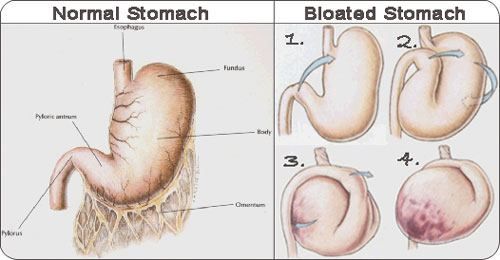What Is Bloat?

The technical name for bloat is "Gastric Dilatation-Volvulus" ("GDV"). Bloating of the stomach is often related to swallowed air (although food and fluid can also be present). It usually happens when there's an abnormal accumulation of air, fluid, and/or foam in the stomach ("gastric dilatation"). Stress can be a significant contributing factor also. Bloat can occur with or without "volvulus" (twisting). As the stomach swells, it may rotate 90° to 360°, twisting between its fixed attachments at the esophagus (food tube) and at the duodenum (the upper intestine). The twisting stomach traps air, food, and water in the stomach. The bloated stomach obstructs veins in the abdomen, leading to low blood pressure, shock, and damage to internal organs. The combined effect can quickly kill a dog.
Gastric Dilatation Volvulus or "Bloat" occurs in many deep chested large breed dogs including the Weimaraner.
Providing the dog normal sized food portions and allowing them time to digest after a meal can help prevent occourrences of bloating, at all ages.
Some Vets may recommend that breeds more prone to bloat undergo surgery to perform a Gastroplexy. This is where the stomach is tacked to the body wall to prevent it from twisting. Please note that this procedure will not stop a dog from bloating however it can buy time until medical help can be sort.
The symptoms of bloat are well known: restlessness, salivation, pacing, labored breathing and other signs of physical distress. Some dogs may also have a distended belly and hunched appearance. Not every dog shows all these symptoms -- in fact, some may show little or no evidence of discomfort. It is vital for owners to be aware of what is normal for their dogs, as bloat is ALWAYS a medical emergency.
Contact Details
Amanda WilliamsonWangaratta, VIC, Australia
